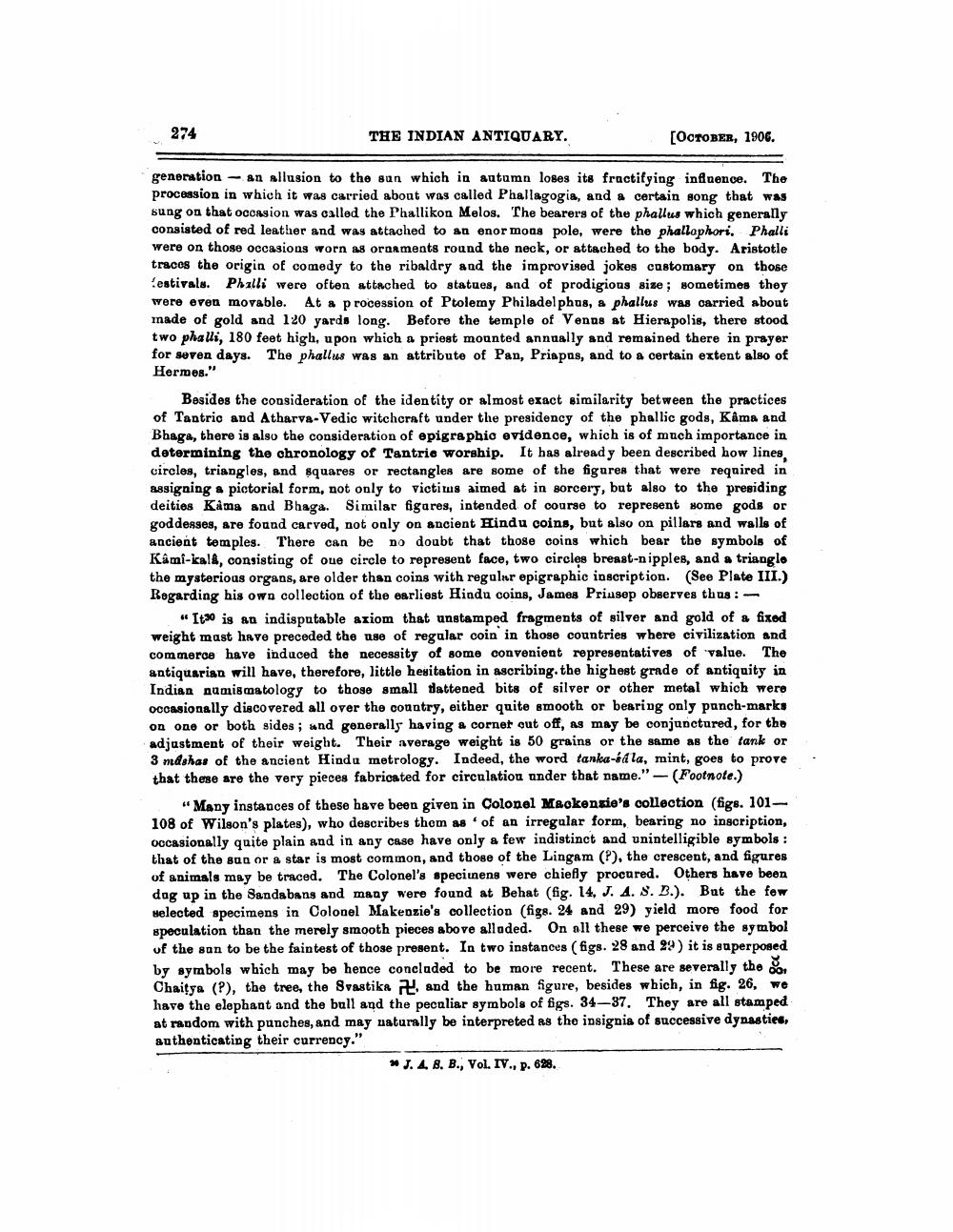________________
274
THE INDIAN ANTIQUARY.
[Остовкв, 1906.
generation an allusion to the sun which in autumn loses its fractifying influence. The procession in which it was carried about was called Phallagogia, and a certain song that was sung on that occasion was called the Phallikon Melos. The bearers of the phallus which generally consisted of red leather and was attached to an enormous pole, were the phallophori. Phalli were on those occasions worn as ornaments round the neck, or attached to the body. Aristotle traces the origin of comedy to the ribaldry and the improvised jokes customary on those festivals. Phalli were often attached to statues, and of prodigious size; sometimes they were even movable. At a procession of Ptolemy Philadelphus, a phallus was carried about made of gold and 120 yards long. Before the temple of Venus at Hierapolis, there stood two phalli, 180 feet high, upon which a priest mounted annually and remained there in prayer for seven days. The phallus was an attribute of Pan, Priapus, and to a certain extent also of Hermes."
Besides the consideration of the identity or almost exact similarity between the practices of Tantric and Atharva-Vedic witchcraft under the presidency of the phallic gods, Kâma and Bhaga, there is also the consideration of epigraphic evidence, which is of much importance in determining the chronology of Tantrie worship. It has already been described how lines, circles, triangles, and squares or rectangles are some of the figures that were required in assigning a pictorial form, not only to victims aimed at in sorcery, but also to the presiding deities Káma and Bhaga. Similar figures, intended of course to represent some gods or goddesses, are found carved, not only on ancient Hindu coins, but also on pillars and walls of ancient temples. There can be no doubt that those coins which bear the symbols of Kami-kala, consisting of oue circle to represent face, two circles breast-nipples, and a triangle the mysterious organs, are older than coins with regular epigraphic inscription. (See Plate III.) Regarding his own collection of the earliest Hindu coins, James Prinsep observes thus: -
"It30 is an indisputable axiom that unstamped fragments of silver and gold of a fixed weight must have preceded the use of regular coin in those countries where civilization and commerce have induced the necessity of some convenient representatives of value. The antiquarian will have, therefore, little hesitation in ascribing. the highest grade of antiquity in Indian numismatology to those small flattened bits of silver or other metal which were occasionally discovered all over the country, either quite smooth or bearing only punch-marks on one or both sides; and generally having a corner out off, as may be conjunctured, for the adjustment of their weight. Their average weight is 50 grains or the same as the tank or 3 mdshas of the ancient Hindu metrology. Indeed, the word tanka-éála, mint, goes to prove that these are the very pieces fabricated for circulation under that name." (Footnote.)
"Many instances of these have been given in Colonel Mackenzie's collection (figs. 101108 of Wilson's plates), who describes them as of an irregular form, bearing no inscription, occasionally quite plain and in any case have only a few indistinct and unintelligible symbols: that of the sun or a star is most common, and those of the Lingam (?), the crescent, and figures of animals may be traced. The Colonel's specimens were chiefly procured. Others have been dag up in the Sandabans and many were found at Behat (fig. 14, J. A. S. B.). But the few selected specimens in Colonel Makenzie's collection (figs. 24 and 29) yield more food for speculation than the merely smooth pieces above alluded. On all these we perceive the symbol of the sun to be the faintest of those present. In two instances (figs. 28 and 29) it is superposed by symbols which may be hence concluded to be more recent. These are severally the Chaitya (P), the tree, the Svastika and the human figure, besides which, in fig. 26, we have the elephant and the bull and the peculiar symbols of figs. 34-37. They are all stamped at random with punches, and may naturally be interpreted as the insignia of successive dynasties, authenticating their currency."
J. A. 8. B., Vol. IV., p. 628.




